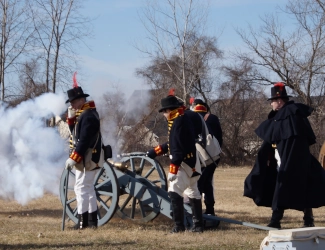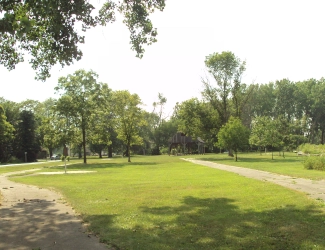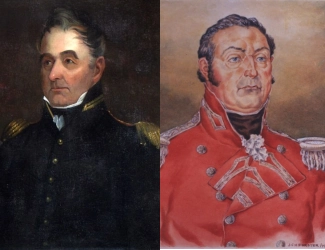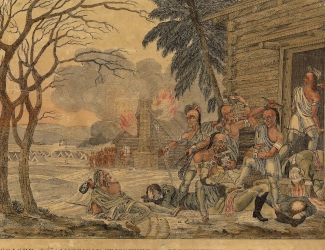
Photo above: Wayside explaining the battles at River Raisin National Battlefield, 2010, Notoriousforlife. Courtesy Wikipedia Commons. Right: Painting of Frenchtown, the town on the banks of River Raisin, Tim Kurtz. Courtesy National Park Service.
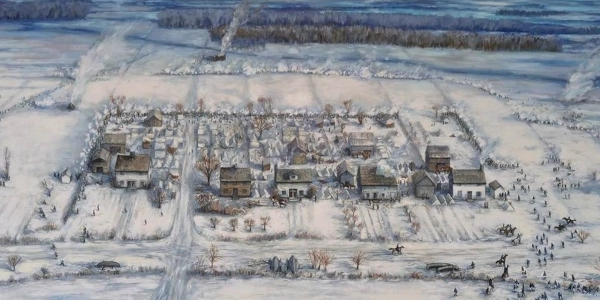
River Raisin National Battlefield
River Raisin National Battlefield where two battles, in January 1813, with opposite victors, first by the Americans who pushed the British out of Frenchtown on fear of its destruction, and the second, a surprising counterattack by Great Britain and its Native American allies that would lead, one day later, to a massacre of prisoners by Native American allies of the British and the call Remember the Raisin. Impact after war led to removal of native tribes from east of the Mississippi River.
Click here to Sponsor the page and how to reserve your ad.
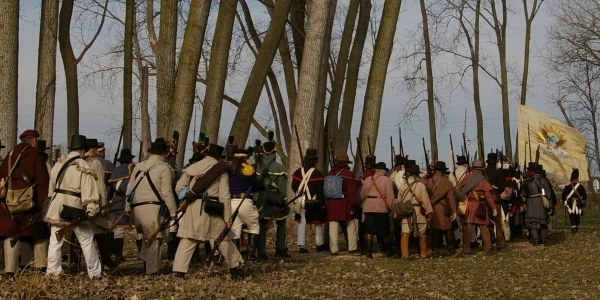
River Raisin Then
To start a history article about the River Raisin, you have to acknowledge that its importance began long before the battles of the War of 1812. This land in Michigan was home to various tribes who used the River Raisin to travel between various points. This included the Potawatomi and Wyandot, but nearly a dozen could claim the territory of lower Michigan up to Detroit as their homeland, and would protect it when French settlers began to arrive in the 1780's to establish farms near Frenchtown. For the next thirty years, there were various incidents as the United States came to power and developed its government. One of which, with various Indian allies on each side, was that Great Britain did not recognize the same boundaries as the American Nation in their Treaty of Paris that ended the American Revolution. Thus all of these influences and incidents began to come to a head.
1808 - "... if we are constrained to lift the hatchet against any tribe, we will never lay it down till that tribe is exterminated, or driven beyond the Mississippi," forecasted Thomas Jefferson.
1810 - "... the only way to stop this evil, is for all the red men to unite in claiming a common and equal right in the land as it was at first, and should be now for it never was divided, but belongs to all… Sell a country! Why not sell the air, the clouds and the great sea, as well as the earth? Did not the Great Spirit make them all for the use of his children?" stated Shawnee chief Tecumseh.
1812 - " ... we and our children are not to be allowed to live on this land more than fifty years… This is not according to the promises… we expect you will not turn us off of our lands at Brownstown and Menguagon aforesaid... Should you grant our wishes as above, we will undertake to keep open, and maintain the good order, all the roads and bridges which may be required on this land, by existing laws, going from Detroit to river Raisin," Wyandot tribe to the President.
June 18, 1812 - The United States declared War on Great Britain.
Photo above: Reenactors of the American Army marching at River Raisin Battlefield. Courtesy National Park Service. Below: A frozen River Raisin today. Courtesy National Park Service.

Minute Walk in History
Enlighten your history knowledge with this War of 1812 battle along the River Raisin south of Detroit, Michigan, that saw two battles followed by an Indian massacre of wounded American prisoners. With video from the National Park Service, learn how these battles would lead to the eventual removal of native tribes from lands east of the Mississippi River.
River Raisin Now
The park is open daily, as well as the new Visitor Center. Park hours are 10:00 a.m. to 5:00 p.m., but is closed on certain holidays. The battlefield has only been open as a National Monument since 2010, so although it has some history for itself, the main history is that surrounding the multiple tribes that inhabited the area and their interaction with the French settlers that came to the riverfront of River Raisin, i.e. Frenchtown.
The focus of the park as a battlefield, of course, must center on the two battles that occurred here, plus the massacre that proceeded them. It may have been less than a week from the first battle pushing the British/Canadian forces out of Frenchtown on January 18, 1813, to the second battle by British and Native Allies to overrun the settlement and American troops on January 22, 1813, in an unexpected attack. One day later, Native American troops would seek revenge on settler attacks in the past by a massacre of prisoners of war who could not walk. Not good on any account.
Associated with the park is the River Raisin Heritage Trail, with an eight mile biking or hiking tour on paved surfaces that take you to various historic sites associated with the battlefield and the close by surrounding area, including the path along River Raisin itself, Sterling State Park and Munson Park, plus historic landmarks in downtown Monroe, Michigan.
There is also a driving tour that takes you further into the history of thirty sites, Native American and French settlement. Ask for the brochure, "River Raisin National Battlefield Park, Great Lakes Theater of the War of 1812; Journey Towards Understanding."
T-Shirts and Souvenirs

River Raisin National Battlefield T-Shirts and Souvenirs.
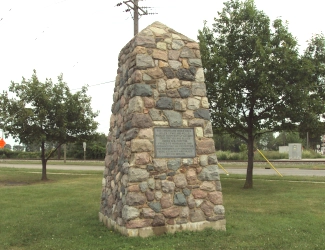
River Raisin National Battlefield
Things You Should Not Miss
1. For us, there are three parts of a visit to River Raisin and the surrounding area. First, go to the new Visitor Center to get oriented, watch the film, and find out if any Ranger guided tours are available. There is a self-guided tour of specific places around the forty-two acre park, if no guided tours are available.
2. If you have the ability to walk eight miles, take the River Ranger Heritage Trail. You'll follow the park, the river, and to historic sites in Monroe. You can walk, bike, and skate your way there and back.
3. Go on the drive, Journey Towards Understanding. This will take a good part of your day as you visit thirty historic sites around the region that talk about the War of 1812 battles and the toll it took on the settlers, tribes, and armies, both during the war, and its impact after the war.
Photo above: Obelist at River Raisin National Battlefield honoring those that fought in the battles, 2010, Notoriousforlife. Courtesy Wikipedia Commons.
